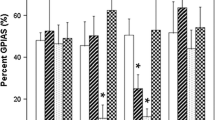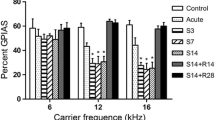Abstract
Aspirin (salicylate), as a common drug that is frequently used for long-term treatment in a clinical setting, has the potential to cause reversible tinnitus. However, few reports have examined the inflammatory cytokines expression and alteration of synaptic ultrastructure in the cochlear nucleus (CN) in a rat model of tinnitus. The tinnitus-like behavior of rats were detected by the gap prepulse inhibition of acoustic startle (GPIAS) paradigm. We investigated the expression levels of the tumor necrosis factor-α (TNF-α), interleukin-6 (IL-6), N-methyl d-aspartate receptor subunit 2A (NR2A) mRNA and protein in the CN and compared synapses ultrastructure in the CN of tinnitus rats with normal ones. GPIAS showed that rats with long-term administration of salicylate were experiencing tinnitus, and the mRNA and protein expression levels of TNF-α and NR2A were up-regulated in chronic treatment groups, and they returned to baseline 14 days after cessation of treatment. Furthermore, compared to normal rats, repetitive salicylate-treated rats showed a greater number of presynaptic vesicles, thicker and longer postsynaptic densities, increased synaptic interface curvature. These data revealed that chronic salicylate administration markedly, but reversibly, induces tinnitus possibly via augmentation of the expression of TNF-α and NR2A and cause changes in synaptic ultrastructure in the CN. Long-term administration of salicylate causes neural plasticity changes at the CN level.






Similar content being viewed by others
Abbreviations
- CN:
-
Cochlear nucleus
- TNF-α:
-
Tumor necrosis factor-α
- IL-6:
-
Interleukin-6
- NMDA:
-
N-methyl-d-aspartate
- NR2A:
-
N-methyl d-aspartate receptor subunit 2A
- GPIAS:
-
gap prepulse inhibition of acoustic startle
References
Bartels, H., M.J. Staal, and F.W. Albers. 2007. Tinnitus and neural plasticity of the brain. Otology & Neurotology: Official Publication of the American Otological Society, American Neurotology Society and European Academy of Otology and Neurotology 28(2): 178–184.
Jastreboff, P.J., J.F. Brennan, J.K. Coleman, and C.T. Sasaki. 1988. Phantom auditory sensation in rats: an animal model for tinnitus. Behavioral Neuroscience 102(6): 811–822.
Paul, A.K., E. Lobarinas, R. Simmons, D. Wack, J.C. Luisi, J. Spernyak, et al. 2009. Metabolic imaging of rat brain during pharmacologically-induced tinnitus. NeuroImage 44(2): 312–318.
Yu, N., M.L. Zhu, B. Johnson, Y.P. Liu, R.O. Jones, and H.B. Zhao. 2008. Prestin up-regulation in chronic salicylate (aspirin) administration: an implication of functional dependence of prestin expression. Cellular and Molecular Life Sciences: CMLS 65(15): 2407–2418.
Huang, Z.W., Y. Luo, Z. Wu, Z. Tao, R.O. Jones, and H.B. Zhao. 2005. Paradoxical enhancement of active cochlear mechanics in long-term administration of salicylate. Journal of Neurophysiology 93(4): 2053–2061.
Yang, K., Z.W. Huang, Z.Q. Liu, B.K. Xiao, and J.H. Peng. 2009. Long-term administration of salicylate enhances prestin expression in rat cochlea. International Journal of Audiology 48(1): 18–23.
Cazals, Y., and Z.W. Huang. 1996. Average spectrum of cochlear activity: a possible synchronized firing, its olivo-cochlear feedback and alterations under anesthesia. Hearing Research 101(1–2): 81–92.
Cazals, Y., K.C. Horner, and Z.W. Huang. 1998. Alterations in average spectrum of cochleoneural activity by long-term salicylate treatment in the guinea pig: a plausible index of tinnitus. Journal of Neurophysiology 80(4): 2113–2120.
Ruel, J., C. Chabbert, R. Nouvian, R. Bendris, M. Eybalin, C.L. Leger, et al. 2008. Salicylate enables cochlear arachidonic-acid-sensitive NMDA receptor responses. The Journal of Neuroscience: The Official Journal of the Society for Neuroscience 28(29): 7313–7323.
Guitton, M.J., and Y. Dudai. 2007. Blockade of cochlear NMDA receptors prevents long-term tinnitus during a brief consolidation window after acoustic trauma. Neural Plasticity 2007: 80904.
Park, H.J., H.J. Kim, G.S. Bae, S.W. Seo, D.Y. Kim, W.S. Jung, et al. 2009. Selective GSK-3beta inhibitors attenuate the cisplatin-induced cytotoxicity of auditory cells. Hearing Research 257(1–2): 53–62.
Fujioka, M., S. Kanzaki, H.J. Okano, M. Masuda, K. Ogawa, and H. Okano. 2006. Proinflammatory cytokines expression in noise-induced damaged cochlea. Journal of Neuroscience Research 83(4): 575–583.
Sun, Y.E., L. Peng, X. Sun, J. Bo, D. Yang, Y. Zheng, et al. 2012. Intrathecal injection of spironolactone attenuates radicular pain by inhibition of spinal microglia activation in a rat model. PloS ONE 7(6): e39897.
Butterworth, R.F. 2008. Pathophysiology of hepatic encephalopathy: the concept of synergism. Hepatology Research: The official journal of the Japan Society of Hepatology 38(Suppl 1): S116–S121.
Kawasaki, Y., L. Zhang, J.K. Cheng, and R.R. Ji. 2008. Cytokine mechanisms of central sensitization: distinct and overlapping role of interleukin-1beta, interleukin-6, and tumor necrosis factor-alpha in regulating synaptic and neuronal activity in the superficial spinal cord. The Journal of Neuroscience : The Official Journal of the Society for Neuroscience 28(20): 5189–5194.
Nakazawa, T. 2009. Mechanism of N-methyl-D-aspartate-induced retinal ganglion cell death. Nippon Ganka Gakkai Zasshi 113(11): 1060–1070.
Saunders, J.C. 2007. The role of central nervous system plasticity in tinnitus. Journal of Communication Disorders 40(4): 313–334.
Kaltenbach, J.A., and D.A. Godfrey. 2008. Dorsal cochlear nucleus hyperactivity and tinnitus: are they related? American Journal of Audiology 17(2): S148–S161.
Baizer, J.S., S. Manohar, N.A. Paolone, N. Weinstock, and R.J. Salvi. 2012. Understanding tinnitus: the dorsal cochlear nucleus, organization and plasticity. Brain Research 1485: 40–53.
Kaltenbach, J.A., M.A. Zacharek, J. Zhang, and S. Frederick. 2004. Activity in the dorsal cochlear nucleus of hamsters previously tested for tinnitus following intense tone exposure. Neuroscience Letters 355(1–2): 121–125.
Robertson, D., C. Bester, D. Vogler, and W.H. Mulders. 2013. Spontaneous hyperactivity in the auditory midbrain: relationship to afferent input. Hearing Research 295: 124–129.
Vogler, D.P., D. Robertson, and W.H. Mulders. 2011. Hyperactivity in the ventral cochlear nucleus after cochlear trauma. The Journal of Neuroscience: The Official Journal of the Society for Neuroscience 31(18): 6639–6645.
Lobarinas, E., S.H. Hayes, and B.L. Allman. 2013. The gap-startle paradigm for tinnitus screening in animal models: limitations and optimization. Hearing Research 295: 150–160.
Engineer, N.D., J.R. Riley, J.D. Seale, W.A. Vrana, J.A. Shetake, S.P. Sudanagunta, et al. 2011. Reversing pathological neural activity using targeted plasticity. Nature 470(7332): 101–104.
Yang, G., E. Lobarinas, L. Zhang, J. Turner, D. Stolzberg, R. Salvi, et al. 2007. Salicylate induced tinnitus: behavioral measures and neural activity in auditory cortex of awake rats. Hearing Research 226(1–2): 244–253.
Su, Y.Y., B. Luo, Y. Jin, S.H. Wu, E. Lobarinas, R.J. Salvi, et al. 2012. Altered neuronal intrinsic properties and reduced synaptic transmission of the rat's medial geniculate body in salicylate-induced tinnitus. PloS ONE 7(10): e46969.
Livak, K.J., and T.D. Schmittgen. 2001. Analysis of relative gene expression data using real-time quantitative PCR and the 2(−Delta Delta C(T)) Method. Methods 25(4): 402–408.
Guldner, F.H., and C.A. Ingham. 1980. Increase in postsynaptic density material in optic target neurons of the rat suprachiasmatic nucleus after bilateral enucleation. Neuroscience Letters 17(1–2): 27–31.
Keithley, E.M., X. Wang, and G.C. Barkdull. 2008. Tumor necrosis factor alpha can induce recruitment of inflammatory cells to the cochlea. Otology & Neurotology: Official Publication of the American Otological Society, American Neurotology Society and European Academy of Otology and Neurotology 29(6): 854–859.
Wakabayashi, K., M. Fujioka, S. Kanzaki, H.J. Okano, S. Shibata, D. Yamashita, et al. 2010. Blockade of interleukin-6 signaling suppressed cochlear inflammatory response and improved hearing impairment in noise-damaged mice cochlea. Neuroscience Research 66(4): 345–352.
Hwang, J.H., J.C. Chen, and Y.C. Chan. 2013. Effects of C-phycocyanin and Spirulina on salicylate-induced tinnitus, expression of NMDA receptor and inflammatory genes. PloS ONE 8(3): e58215.
Hwang, J.H., J.C. Chen, S.Y. Yang, M.F. Wang, and Y.C. Chan. 2011. Expression of tumor necrosis factor-alpha and interleukin-1beta genes in the cochlea and inferior colliculus in salicylate-induced tinnitus. Journal of Neuroinflammation 8: 30.
Park, K.M., and W.J. Bowers. 2010. Tumor necrosis factor-alpha mediated signaling in neuronal homeostasis and dysfunction. Cellular Signalling 22(7): 977–983.
Weber, C., P. Arck, B. Mazurek, and B.F. Klapp. 2002. Impact of a relaxation training on psychometric and immunologic parameters in tinnitus sufferers. Journal of Psychosomatic Research 52(1): 29–33.
Budd, R.J., and R. Pugh. 1995. The relationship between locus of control, tinnitus severity, and emotional distress in a group of tinnitus sufferers. Journal of Psychosomatic Research 39(8): 1015–1018.
McAfoose, J., and B.T. Baune. 2009. Evidence for a cytokine model of cognitive function. Neuroscience and Biobehavioral Reviews 33(3): 355–366.
Seidel, A., V. Arolt, M. Hunstiger, L. Rink, A. Behnisch, and H. Kirchner. 1995. Cytokine production and serum proteins in depression. Scandinavian Journal of Immunology 41(6): 534–538.
Guitton, M.J., J. Caston, J. Ruel, R.M. Johnson, R. Pujol, and J.L. Puel. 2003. Salicylate induces tinnitus through activation of cochlear NMDA receptors. The Journal of Neuroscience: The Official Journal of the Society for Neuroscience 23(9): 3944–3952.
Peng, B.G., S. Chen, and X. Lin. 2003. Aspirin selectively augmented N-methyl-d-aspartate types of glutamate responses in cultured spiral ganglion neurons of mice. Neuroscience Letters 343(1): 21–24.
Kaltenbach, J.A., J. Zhang, and P. Finlayson. 2005. Tinnitus as a plastic phenomenon and its possible neural underpinnings in the dorsal cochlear nucleus. Hearing Research 206(1–2): 200–226.
Sahley, T.L., M.D. Hammonds, and F.E. Musiek. 2013. Endogenous dynorphins, glutamate and N-methyl-d-aspartate (NMDA) receptors may participate in a stress-mediated Type-I auditory neural exacerbation of tinnitus. Brain Research 1499: 80–108.
Acknowledgments
This study was supported by the National Natural Science Foundation of China (No. 81170917, No.30973298) and the Creative Project of the Shanghai Municipal Education Committee (No. 12ZZ103) to Zhi-Wu Huang.
Competing interests
The authors declare that they have no competing interests.
Author information
Authors and Affiliations
Corresponding author
Rights and permissions
About this article
Cite this article
Hu, SS., Mei, L., Chen, JY. et al. Effects of Salicylate on the Inflammatory Genes Expression and Synaptic Ultrastructure in the Cochlear Nucleus of Rats. Inflammation 37, 365–373 (2014). https://doi.org/10.1007/s10753-013-9748-2
Published:
Issue Date:
DOI: https://doi.org/10.1007/s10753-013-9748-2




